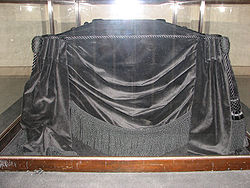
A catafalque is a raised bier, box, or similar platform, often movable, that is used to support the casket, coffin, or body of a dead person during a Christian funeral or memorial service. [1] Following a Roman Catholic Requiem Mass, a catafalque may be used to stand in place of the body at the absolution of the dead or used during Masses of the Dead and All Souls' Day. [2]

